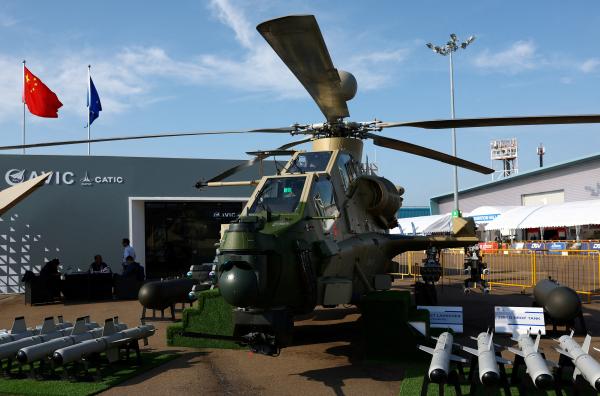SINGAPORE, Feb 23 — The Singapore Airshow included the foreign debuts of new weapons systems, growing interest in systems that could destroy ballistic missiles, and swat down drones — but it was missing any Russian presence and major defence deals were scarce.
The trade portion of Asia's biggest aviation gathering ended today, with exhibitors packing up their sprawling displays of military hardware, aerospace services, parts, and national pride.
After days of demonstration flights, Asian military acrobatic teams took a break today when no aerial displays were scheduled in advance of the public air show tomorrow and on Sunday (February 25).
Unlike previous years, no Russian companies were presenting their wares at the air show. With international sanctions hobbling business and the invasion of Ukraine sapping supplies, competitors said there were opportunities to step in with some Asian operators of Russian gear.
"In this region, you have seen a shift away from Russian equipment already. Of course there are some natural client countries... who stay where they are in terms of suppliers," said Robert Hewson of Sweden's Saab.
Several Southeast Asian countries, including Malaysia, Indonesia, Vietnam, Cambodia, and Laos, also use Russian-made or Soviet Union-vintage equipment, sometimes alongside Western-made gear. Russia's largest arms exporters did not respond to Reuters requests for comment.
Israel's defence industry made a quiet return after being largely absent from the Dubai air show in November in the wake of the Israel-Hamas war — a subject the companies were reluctant to discuss.
IAI, Rafael, Elbit, and the Israeli Defence Ministry all declined to comment on anything involving the war in Gaza, including the performance of their weapons.
The war was not brought up by delegates at the Singapore event and did not dampen appetite for Israel's missiles, spy gear, and aerial drones, two Israeli industry officials at the show told Reuters, asking not to be named because of the sensitivity of the matter.
[caption id="attachment_346906" align="aligncenter" width="842"] An Indonesian Air Force cadet watches the South Korean Air Force’s Black Eagles aerobatic team perform in their T-50Bs during an aerial display at the Singapore Airshow at Changi Exhibition Centre in Singapore, on February 22, 2024. — Picture by REUTERS[/caption]
An Indonesian Air Force cadet watches the South Korean Air Force’s Black Eagles aerobatic team perform in their T-50Bs during an aerial display at the Singapore Airshow at Changi Exhibition Centre in Singapore, on February 22, 2024. — Picture by REUTERS[/caption]
Missiles, Helicopters
The barrage of anti-ship ballistic missiles in the Red Sea, meanwhile, led to an interest in systems that could not just protect against those threats, but also smaller, cheaper missiles and drones, attendees said.
On the sidelines of the air show, a senior executive at a United States (US) defence contractor said the activity in the Red Sea by Yemen's Iran-aligned Houthis and in Ukraine had caught the attention of potential customers in Asia.
"What we are seeing is demand increase for integrated air and missile defence here," said the executive, who declined to be named because of the sensitivity of the matter.
He said that included sensors to detect targets, the weapons to shoot them down and the command-and-control systems tying it all together.
Jeffrey Lewis, director of the East Asia Nonproliferation Program at the Center for Nonproliferation Studies, said the cost of such systems might make it more economical — based on the experience in the Red Sea — to simply try to destroy the attacking weapons on the ground.
"At the end of the day, we turned to offensive systems to strike the launchers. That implies that defences are a very expensive niche capability. Why shoot the arrow when you can shoot the archer?" he said.
US Navy destroyers are equipped with the Aegis air defence system, with components from Lockheed Martin, among others, which is designed to shoot down aircraft, cruise missiles, and ballistic missiles.
Aegis uses RTX subsidiary Raytheon's SM-2, SM-3 and SM-6 missiles to intercept threats. A Raytheon spokesperson declined to comment on whether the company had seen increased interest in missile defence systems since the Houthi attacks began. A Lockheed Martin spokesperson provided public information about the increased production of certain systems.
Among the notable weapon systems on display at the show was the Z-10 attack helicopter, made by China's AVIC, which made its first trip outside Chinese territory in Singapore.
China hopes to export the helicopter. Experts and attendees said the number of potential customers might be small in Asia.
"The performance and capabilities of this platform would certainly make it of interest for export," said Malcolm Davis, a senior analyst at the Australian Strategic Policy Institute. He named Laos, Cambodia, and Myanmar as possible buyers.
Although several commercial deals were announced at the air show, and "sustainability" was a buzzword throughout, the defence side of the show ended quietly, with a discussion of hopes for future sales but no big announcements.
— Reuters
[caption id="attachment_346907" align="aligncenter" width="812"] Cambodia's Armed Forces Commander-in-chief Vong Pisen tours the Aviation Industry Corporation of China (AVIC) booth during the Singapore Airshow at Changi Exhibition Centre in Singapore, on February 20, 2024. — Picture by REUTERS[/caption]
Cambodia's Armed Forces Commander-in-chief Vong Pisen tours the Aviation Industry Corporation of China (AVIC) booth during the Singapore Airshow at Changi Exhibition Centre in Singapore, on February 20, 2024. — Picture by REUTERS[/caption]




